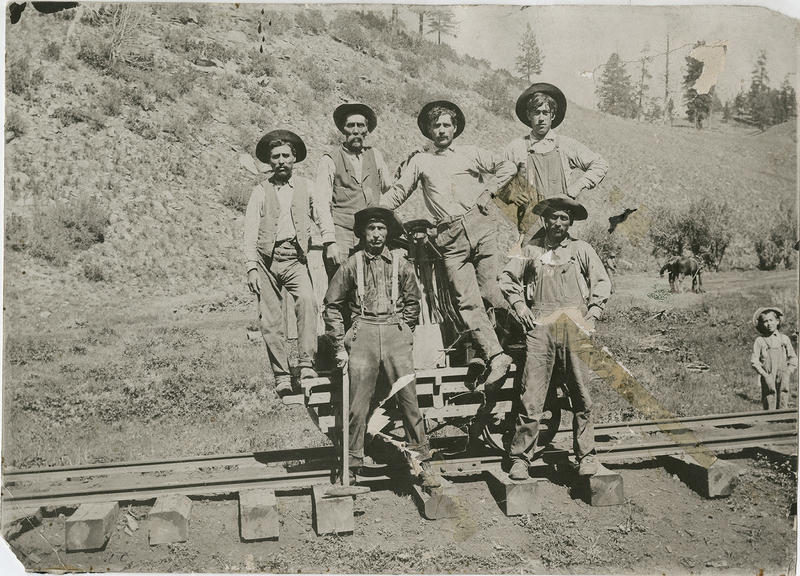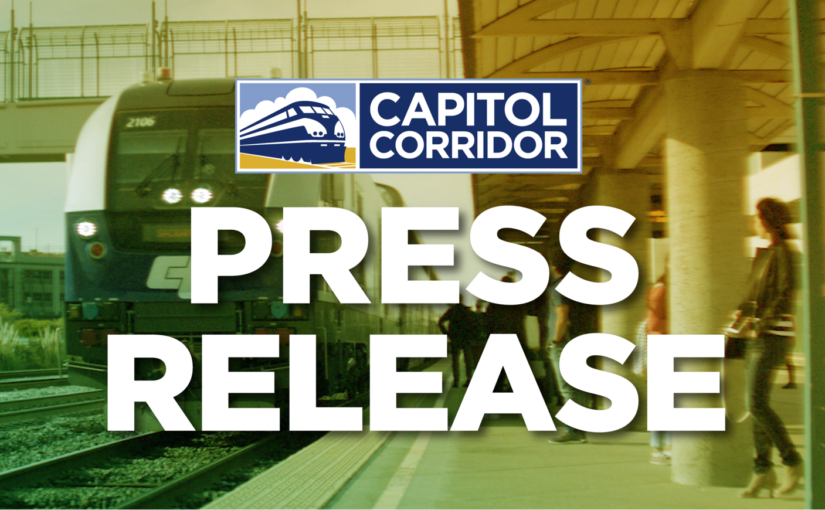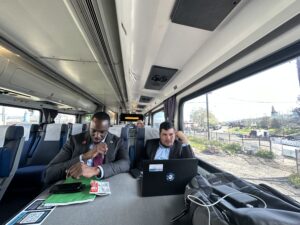A more sustainable fuel made from renewable raw materials will soon run rail fleets in California
Oakland, CA, April 22, 2023 – Capitol Corridor and San Joaquins intercity passenger rail services will achieve their goal to run their entire fleets on renewable diesel by end of May 2023. The transition will begin on May 8, at the Oakland Maintenance Facility when the renewable diesel tank is slated for delivery.
“The successful testing of renewable diesel to run locomotives was spearheaded by Capitol Corridor and as a result, intercity passenger rail services throughout California will soon run on cleaner fuel,” Capitol Corridor Joint Powers Authority (CCJPA) Chair Robert Raburn said. CCJPA is the entity that manages Northern California’s intercity passenger rail service. “The project was a collaborative effort of statewide partners committed to advance California’s goal of zero emissions,” Raburn added.
What is Renewable Diesel (RD)?
RD is chemically similar to fossil diesel but made from renewable raw materials such as used cooking oil, not crude oil. Because RD is produced by utilizing the already existing carbon stored in the renewable raw materials in nature, when the fuel is combusted, the carbon dioxide it emits is not considered as adding new carbon to the atmosphere. The use of fossil diesel, on the contrary, releases new carbon dioxide and other greenhouse gases, contributing to climate change. Other emissions, such as fine particulates and nitrogen oxides may also be reduced through the use of renewable diesel, which improves local air quality.
State and federal partners collaborate to find new fuel source for California passenger rail
“CCJPA initiated the exploration of alternative fuel options in collaboration with the California Air Resources Board (CARB),” Robert Padgette, CCJPA Managing Director said. “The California State Transportation Agency (CalSTA) stepped up to fund the testing and worked with the passenger rail equipment manufacturers to ensure the efficacy of the new fuel source. CalSTA also worked with the U.S. Environmental Protection Agency (EPA) to obtain official certification” Robert Padgette, CCJPA Managing Director added.
Transitioning from polluting fuels to a more sustainable option is aimed to reduce a fleet’s environmental impact, but it is an effort that takes technical expertise, funding as well as regional and federal oversight. To protect public health, the EPA has stringent standards to reduce fine particles and other harmful emissions from locomotive engines as well as the fuel trains use.
California Intercity Passenger Rail services team up for cleaner air
Soon passenger rail travelers throughout California will know their trips are helping to combat climate change and air pollution as other rail services will soon fuel their entire fleets with RD.
“Switching to renewable diesel has been a strategic initiative for the San Joaquins,” Brian Schmidt, Director of Equipment Services at the San Joaquin Joint Powers Authority (SJJPA) said. “SJJPA would like to thank CCJPA for its leadership in converting our shared fleet to renewable diesel. Our collective commitment to reducing greenhouse gas emissions has taken a large step forward.”
”As we implement on our Climate Commitment, we welcome new ways to support Amtrak trains in California – including the 170-mile long Capitol Corridor route,” said Jeanne Cantu. Amtrak Vice President, California. “We are thrilled that the pilot’s success allows us to operate on renewable diesel resulting in fewer lifecycle emissions throughout California.”
Testing partnership showcases the potential for rail industry to swap to renewable diesel
CCJPA, worked with Amtrak, fuel distributor RD contractor Western States Oil, and RD producer Neste, world’s leading producer of RD, to successfully complete testing of Neste MY Renewable Diesel™ in August 2022. RD certification followed in November 2022. Neste MY Renewable Diesel is fully compatible with all diesel engines and current diesel fuel distribution infrastructure, so Capitol Corridor did not need any extra investments or modifications to make the switch. Made from sustainably sourced, 100% renewable raw materials, Neste MY Renewable Diesel can reduce up to 75% of GHG emissions over its life cycle compared to fossil diesel.*
“We are thrilled to help Capitol Corridor complete the testing of Neste MY Renewable Diesel in their locomotive,” says Carrie Song, Vice President, Americas from Renewable Road Transportation business unit at Neste. “Renewable diesel is a solution available already today to reduce GHG emissions from all diesel engines. This testing showcases the potential of using renewable diesel to combat climate change for the rail industry.”
*Per Neste sources, the GHG emission reduction varies depending on the region-specific legislation that provides the methodology for the calculations (e.g. EU RED II 2018/2001/EU for Europe and US California LCFS for the US), and the raw material mix used to manufacture the product for each market.
About CCJPA and the Capitol Corridor®
Managed by the Capitol Corridor Joint Powers Authority (CCJPA), the Capitol Corridor is an intercity rail service connecting the most economically vibrant urban centers in Northern California – from Sacramento to Silicon Valley, and including San Francisco, Oakland, and Berkeley. With free Wi-i Fi on board, Capitol Corridor trains provide a convenient, reliable, and comfortable alternative to the congested I-80, I-680, and I-880 freeways for more than 700,000 passengers a year. For more information, visit capitolcorridor.org.
About the San Joaquin Joint Powers Authority (SJJPA)
Since July 2015, SJJPA has been responsible for the management and administration of Amtrak San Joaquins. SJJPA is governed by Board Members representing each of the ten (10) Member Agencies along the 365-mile San Joaquins Corridor. For more information on SJJPA see www.sjjpa.com. Amtrak San Joaquins is Amtrak’s 6th busiest route with 1 million annual riders and 18 stations providing a safe, comfortable and reliable way to travel throughout California. Prior to service modifications due to the COVID-19 crisis, Amtrak San Joaquins operated 7 daily train round-trips and its Thruway buses provided connecting service to over 100 destinations in California and Nevada including Los Angeles, Santa Barbara, San Diego, Napa Valley, Las Vegas and Reno. To book your next trip, visit www.AmtrakSanJoaquins.com or call 1-800-USA-RAIL.
Contacts:
Priscilla Kalugdan






